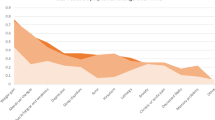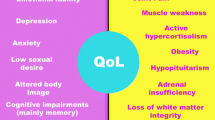Abstract
Background
Cushing’s disease (CD) is a rare disorder of chronic hypercortisolism due to an adrenocorticotropic hormone (ACTH)-secreting pituitary corticotroph adenoma. Because hypercortisolism symptoms are wide ranging, it is important to assess a variety of outcomes including both clinical factors, such as cortisol levels, and health-related quality of life (HR-QOL), to better understand the severity and impact of CD on patients and the potential efficacy of CD treatment. Pasireotide, a somatostatin analog that targets somatostatin receptors on the pituitary adenoma, is under development as a treatment for CD. A phase III clinical trial was conducted to investigate its safety and efficacy in patients with CD. In this trial, HR-QOL was assessed with the Cushing’s Quality-of-Life (CushingQOL) questionnaire, specifically developed and validated in patients with Cushing’s syndrome.
Objective
Reliability, validity, the ability to detect change, and a minimal important difference (MID) were evaluated for the CushingQOL questionnaire using data from patients diagnosed with CD who participated in the phase III clinical trial designed to assess the safety and efficacy of different doses of pasireotide.
Methods
Adult patients (n = 162) with CD participated in a randomized, double-blind, multinational, phase III clinical trial. Patients received subcutaneous pasireotide (600 μg or 900 μg) twice daily for 3 months (double blind). After 3 months, some patients were unblinded based on their mean urinary free cortisol (mUFC) levels and were given the chance to increase their dosage, while the other patients remained blinded. At month 6, an open-label 6-month period began. The CushingQOL questionnaire was self-administered four times (baseline [n = 160], and at months 3 [n = 134], 6 [n = 113], and 12 [n = 76]). A confirmatory factor analysis (CFA) was conducted. Reliability estimates were calculated for internal consistency (coefficient alpha) and test retest (intraclass correlation coefficients [ICCs]) for patients with stable hypercortisolism at month 3 and month 6. Construct validity hypotheses (correlations), mean differences in known groups (ANOVAs), and responsiveness effect sizes (Guyatt’s) were estimated based on measures of cortisol, body mass index (BMI), waist circumference, weight, facial rubor (redness), striae (stretch marks), bruising, supraclavicular fat pad, dorsal fat pad, and results of the Beck Depression Inventory II (BDI-II). The half-standard deviation distribution method was used to estimate MID.
Results
CFA loadings supported a one-factor solution for the CushingQOL questionnaire items. Internal consistency reliability (0.87–0.88) and ICCs (0.87) were high. Construct validity hypotheses were in the anticipated direction. Changes in CushingQOL scores were moderately correlated with changes in mUFC levels, in BMI, and in weight. Mean scores for minimally depressed patients were significantly higher (indicating better HR-QOL) than for severely depressed patients. Moderate Guyatt’s responsiveness effect sizes were observed for patients who achieved reductions in weight, BMI, and waist circumference. Using the half-standard deviation method, an estimate of the MID was computed as 10.1.
Conclusions
This study provided evidence within the context of a longitudinal design that the CushingQOL questionnaire is a reliable, valid, and responsive instrument for the assessment of HR-QOL in adults with CD in accordance with recommendations set forth by regulatory agencies in the USA and Europe.

Similar content being viewed by others
References
Webb SM, Badia X, Barahona MJ, et al. Evaluation of health-related quality of life in patients with Cushing’s syndrome with a new questionnaire. Eur J Endocrin. 2008;158:623–30.
Colao A, Petersenn S, Newell-Price J, et al. A 12-month phase 3 study of pasireotide in Cushing’s disease [published erratum appears in N Engl J Med. 2012;367(8):780]. N Engl J Med. 2012;366(10):914–24.
Lindsay JR, Nansel T, Baid S, et al. Long-term impaired quality of life in Cushing’s syndrome despite initial improvement after surgical remission. J Clin Endocrinol Metab. 2006;91:447–53.
van Aken MO, Pereira AM, Biermasz NR, et al. Quality of life in patients after long-term biochemical cure of Cushing’s disease. J Clin Endocrinol Metab. 2005;90:3279–86.
Gotch PM. Cushing’s syndrome from the patient’s perspective. Endocrinol Metab Clin N Am. 1994;23:607–17.
Webb SM, Santos A, Resmini E, Valassi E, et al. Chapter 4: Quality of life and long term follow up. In: Lambers SWJ, editor. Handbook of Cushing’s disease. Bristol: BioScientifica; 2011.
Santos A, Resmini E, Martínez MA, et al. Psychometric Performance of the CushingQol questionnaire in conditions of real clinical practice. Eur J Endocrinol. 2012;167:47–61.
Committee for Medicinal Products for Human Use, European Medicines Agency. Reflection paper on the regulatory guidance for the use of health-related quality of life (HRQL) measures in the evaluation of Medicinal products. London: EMA; July 2005. http://www.ema.europa.eu/docs/en_GB/document_library/Scientific_guideline/2009/09/WC500003637.pdf. Accessed 30 Jan 2012.
US Department of Health and Human Services, FDA, CDER, CBER, CDRH. Guidance for industry - patient-reported outcome measures: use in medical product development to support labeling claims. Washington, DC: US Department of Health and Human Services, Dec 2009. http://www.fda.gov/downloads/Drugs/GuidanceComplianceRegulatoryInformation/Guidances/UCM193282.pdf. Accessed 11 Nov 2010.
Badia X, Barahona MJ, Glusman J, et al. Strategy for developing a specific Cushing’s syndrome QOL questionnaire. In: 12th ISOQOL Conference on Patient Reported Outcomes in Clinical Practice, 24–26 June 2007; Budapest.
Whisman MA, Perez JE, Ramel W. Factor structure of the Beck Depression Inventory, 2nd ed. (BDI-II) in a student sample. J Clin Psychol. 2000;56:545–51.
Jöreskog KG, Sörbom D. LISREL® 8.50. User’s reference guide. Chicago: Scientific Software International, Inc.; 1996.
Jöreskog KG, Sörbom D. LISREL VI: analysis of linear structural relationships by maximum likelihood and least squares methods. Mooresville: Scientific Software, Inc.; 1986.
Schumacker RE, Lomax RG. A beginner’s guide to structural equation modeling. Mahwah: Lawrence Erlbaum Associates; 1996.
Cronbach L. Coefficient alpha and the internal structure of tests. Psychometrika. 1951;16:294–334.
Schuck P. Assessing reproducibility for interval data in health-related quality of life questionnaires: which coefficient should be used? Qual Life Res. 2004;13:571–86.
Cohen J. Statistical power analysis for the behavioral sciences. 2nd ed. Hillsdale: Lawrence Erlbaum Associates; 1988.
Guyatt GH, Walter SD, Norman G. Measuring change over time: assessing the usefulness of evaluative instruments. J Chronic Dis. 1987;40:171–8.
Norman GR, Sloan JA, Wyrwich KW. Interpretation of changes in health-related quality-of-life: the remarkable universality of half a standard deviation. Med Care. 2003;4:582–92.
Webb SM, Badia X, Lara N. Validity and clinical applicability of the acromegaly quality of life questionnaire, AcroQOL: a 6 month prospective study. Eur J Endocrinol. 2006;155:269–77.
Acknowledgments
This work was a collaboration between Novartis, IMS Health, and RTI Health Solutions (RTI-HS) with the financial support of Novartis. Novartis (USA or Switzerland) employees included Anna Forsythe, Sonia Pulgar (now employed by GlaxoSmithKline, Research Triangle Park, NC, USA), Mario Maldonado, and Yanqiong Zhang. Consultants, who were paid by Novartis, included Lori McLeod, Lauren M. Nelson, and Theresa Coles (RTI-HS employees); Susan M. Webb (Universitat Autònoma de Barcelona employee); and Xavier Badia (IMS Health employee). The authors thank the sites and patients included in the clinical study as well as the two anonymous reviewers who provided thoughtful comments and suggestions.
Author Contributions
Lauren M. Nelson and Theresa Coles were involved in the development of the analysis plan, analyses, and interpretation of the data. Anna Forsythe was involved in the planning of the manuscript, including acquiring the data, critical review, and revision to the analysis plan, and interpretation of the data. Lori McLeod was involved in the development of the analysis plan as well as review of the analyses and interpretation. Sonia Pulgar and Mario Maldonado were involved in the planning of the study as well as critical review and revision of the analysis plan, and interpretation of the data. Yanqiong Zhang was involved in critical review of the analysis plan, acquiring data, critical review of the analyses, and interpretation of the data. Susan M. Webb and Xavier Badia were involved in the development of the CushingQOL questionnaire, critical review and revision of the analysis plan, and interpretation of the data. All authors were involved in the drafting of sections of the manuscript and approved the final version. Lauren M. Nelson is the corresponding author and guarantor of the overall content.
Author information
Authors and Affiliations
Corresponding author
Rights and permissions
About this article
Cite this article
Nelson, L.M., Forsythe, A., McLeod, L. et al. Psychometric Evaluation of the Cushing’s Quality-of-Life Questionnaire. Patient 6, 113–124 (2013). https://doi.org/10.1007/s40271-013-0012-5
Published:
Issue Date:
DOI: https://doi.org/10.1007/s40271-013-0012-5




